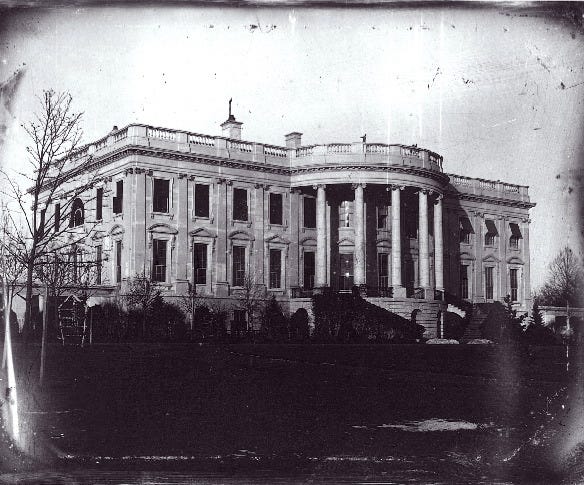TDIH: First President in D.C.
The President’s move to Washington was the culmination of many years’ hard work—and an important compromise.
On this day in 1800, John Adams becomes the first President to officially take up residence in Washington, D.C. Much of the city was still under construction, and the White House wasn’t even finished yet. Maybe it is unsurprising that Adams didn’t stay too long before heading home for a long visit in Massachusetts?
David McCullough describes the scene that confronted Adams when he reached Washington on that day in June:
“For all the talk, there was no city as yet, only a rather shabby village and great stretches of tree stumps, stubble, and swamp. There were no schools, not a single church. Capitol Hill comprised a few stores, a few nondescript hotels and boardinghouses clustered near a half-finished sandstone Capitol. To accommodate the different departments of the government, only one structure had been completed, the Treasury . . . .”
Nevertheless, Adams was optimistic in the letter that he wrote to Abigail. “I like the Seat of Government very well,” he wrote her, “and shall Sleep, or lie awake next Winter in the Presidents house.”
The President’s move to Washington was the culmination of many years’ hard work—and an important compromise.
The location of the nation’s new capital had been hotly contested in the First Congress. The Constitution left the decision to congressmen, but you can imagine that everyone wanted the honor for themselves. Yet even as congressmen pondered the decision about the capital, another matter was also pending: Would the federal government assume responsibility for the Revolutionary War debts held by the states? The matter was a contentious one, partly because some southern states had less debt than the northern states.
In the end, Alexander Hamilton, James Madison, and Thomas Jefferson brokered a deal that would become the basis for congressional action. The South would agree to the assumption of states’ debts, but in return it would gain the new capital. Philadelphia would serve as a temporary capital while the new one, by the Potomac, was being built. George Washington was asked to choose the exact spot near the Potomac, which he did, choosing a site not too far away from Mount Vernon.
This “Act for Establishing the Temporary and Permanent Seat of the Government of the United States” was approved in July 1790.
Washington was authorized by the Act to oversee the plans for the city, and he selected Pierre Charles L’Enfant to design it. L’Enfant’s selection proved to be a bit of a problem. He became embroiled in multiple disputes with the city’s commissioners and eventually had to be fired. These design problems, along with lack of funding, caused construction to proceed slowly.
Can you believe that fewer than 300 federal employees moved to the city when Adams did in June 1800?
The President and First Lady were finally able to move into a semi-complete White House in November 1800. They would not live there long, however. Adams was defeated by Thomas Jefferson in the election of 1800 and thus moved out of the White House when Jefferson was inaugurated in March 1801.
Sources can always be found on my website, here.





Like the decision to declare independence, wage war against the Mother land, accomplish the writing and passing of the Constitution and so many other major decisions, choosing a location for the seat of government required compromise.
Our forefathers deserve so many accolades for their ability to reach consensus - a quality our current "leaders" sorely need.
Thank you Tara.
Men with integrity, honesty and love, sadly missing in the world today.